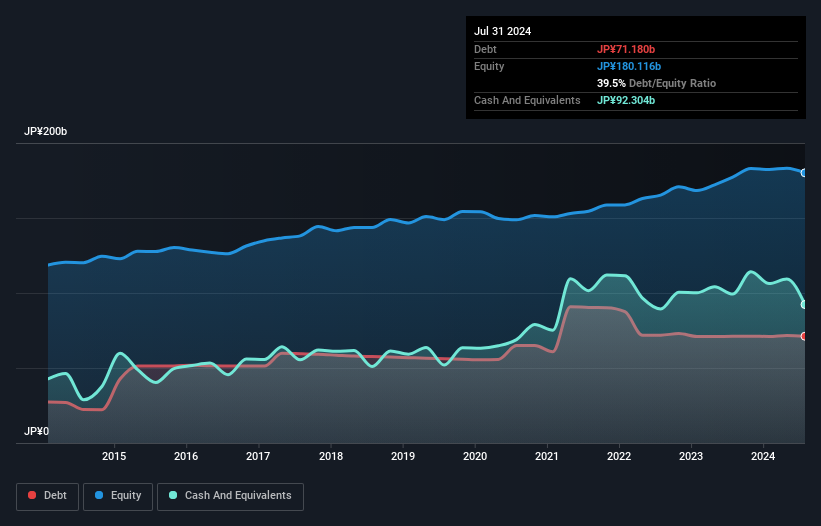These 4 Measures Indicate That Ito En (TSE:2593) Is Using Debt Reasonably Well
David Iben put it well when he said, 'Volatility is not a risk we care about. What we care about is avoiding the permanent loss of capital.' So it seems the smart money knows that debt - which is usually involved in bankruptcies - is a very important factor, when you assess how risky a company is. As with many other companies Ito En, Ltd. (TSE:2593) makes use of debt. But the real question is whether this debt is making the company risky.
Why Does Debt Bring Risk?
Generally speaking, debt only becomes a real problem when a company can't easily pay it off, either by raising capital or with its own cash flow. If things get really bad, the lenders can take control of the business. However, a more frequent (but still costly) occurrence is where a company must issue shares at bargain-basement prices, permanently diluting shareholders, just to shore up its balance sheet. By replacing dilution, though, debt can be an extremely good tool for businesses that need capital to invest in growth at high rates of return. The first thing to do when considering how much debt a business uses is to look at its cash and debt together.
Check out our latest analysis for Ito En
How Much Debt Does Ito En Carry?
The chart below, which you can click on for greater detail, shows that Ito En had JP¥71.2b in debt in July 2024; about the same as the year before. However, it does have JP¥92.3b in cash offsetting this, leading to net cash of JP¥21.1b.

How Strong Is Ito En's Balance Sheet?
We can see from the most recent balance sheet that Ito En had liabilities of JP¥114.6b falling due within a year, and liabilities of JP¥57.8b due beyond that. On the other hand, it had cash of JP¥92.3b and JP¥73.6b worth of receivables due within a year. So it has liabilities totalling JP¥6.45b more than its cash and near-term receivables, combined.
This state of affairs indicates that Ito En's balance sheet looks quite solid, as its total liabilities are just about equal to its liquid assets. So while it's hard to imagine that the JP¥340.7b company is struggling for cash, we still think it's worth monitoring its balance sheet. While it does have liabilities worth noting, Ito En also has more cash than debt, so we're pretty confident it can manage its debt safely.
On the other hand, Ito En saw its EBIT drop by 6.0% in the last twelve months. If earnings continue to decline at that rate the company may have increasing difficulty managing its debt load. When analysing debt levels, the balance sheet is the obvious place to start. But it is future earnings, more than anything, that will determine Ito En's ability to maintain a healthy balance sheet going forward. So if you want to see what the professionals think, you might find this free report on analyst profit forecasts to be interesting.
Finally, a business needs free cash flow to pay off debt; accounting profits just don't cut it. Ito En may have net cash on the balance sheet, but it is still interesting to look at how well the business converts its earnings before interest and tax (EBIT) to free cash flow, because that will influence both its need for, and its capacity to manage debt. Over the most recent three years, Ito En recorded free cash flow worth 77% of its EBIT, which is around normal, given free cash flow excludes interest and tax. This free cash flow puts the company in a good position to pay down debt, when appropriate.
Summing Up
We could understand if investors are concerned about Ito En's liabilities, but we can be reassured by the fact it has has net cash of JP¥21.1b. The cherry on top was that in converted 77% of that EBIT to free cash flow, bringing in JP¥16b. So we don't think Ito En's use of debt is risky. Over time, share prices tend to follow earnings per share, so if you're interested in Ito En, you may well want to click here to check an interactive graph of its earnings per share history.
At the end of the day, it's often better to focus on companies that are free from net debt. You can access our special list of such companies (all with a track record of profit growth). It's free.
New: AI Stock Screener & Alerts
Our new AI Stock Screener scans the market every day to uncover opportunities.
• Dividend Powerhouses (3%+ Yield)
• Undervalued Small Caps with Insider Buying
• High growth Tech and AI Companies
Or build your own from over 50 metrics.
Have feedback on this article? Concerned about the content? Get in touch with us directly. Alternatively, email editorial-team (at) simplywallst.com.
This article by Simply Wall St is general in nature. We provide commentary based on historical data and analyst forecasts only using an unbiased methodology and our articles are not intended to be financial advice. It does not constitute a recommendation to buy or sell any stock, and does not take account of your objectives, or your financial situation. We aim to bring you long-term focused analysis driven by fundamental data. Note that our analysis may not factor in the latest price-sensitive company announcements or qualitative material. Simply Wall St has no position in any stocks mentioned.
About TSE:2593
Ito En
Manufactures and sells green tea beverages in Japan and internationally.
Flawless balance sheet with proven track record.
Market Insights
Community Narratives



